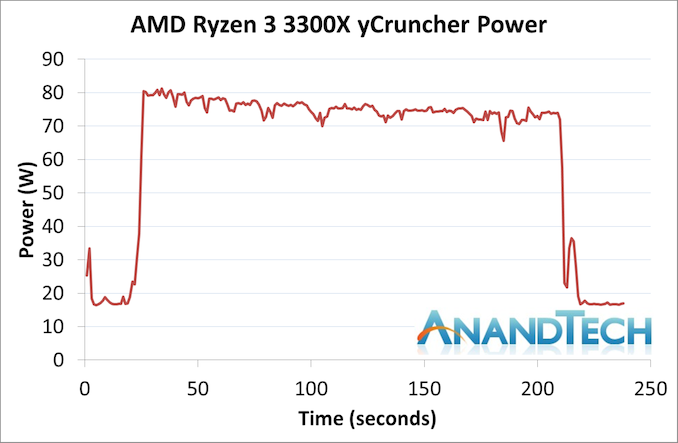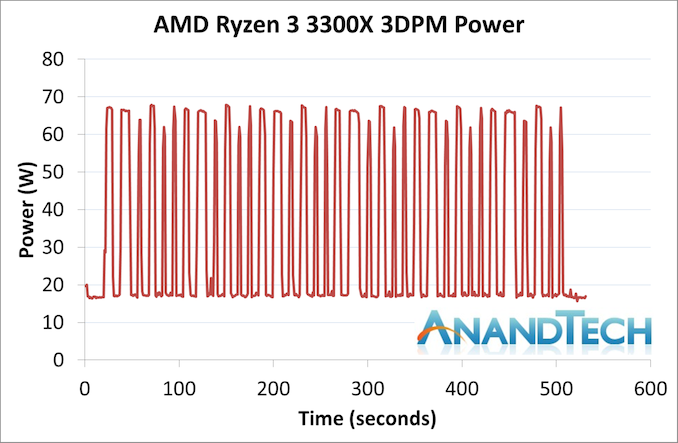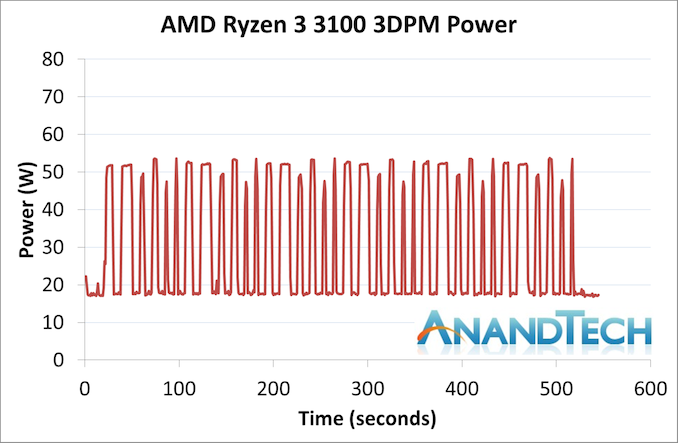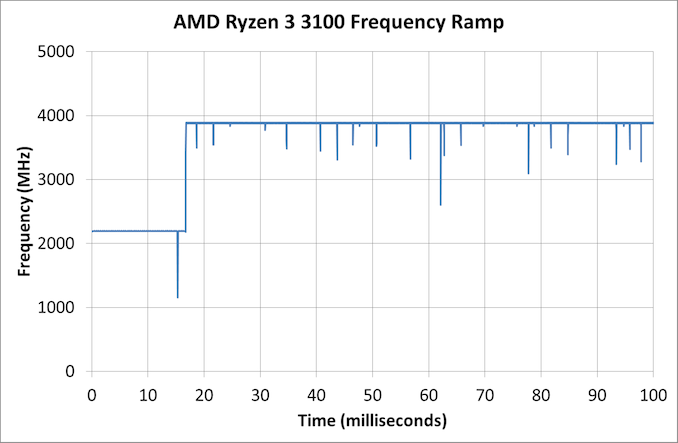The AMD Ryzen 3 3300X and 3100 CPU Review: A Budget Gaming Bonanza
by Dr. Ian Cutress on May 7, 2020 9:00 AM ESTPower Consumption and Frequency Ramps
On the box, both processors are listed as having 65 W TDPs. With its Zen-based hardware, AMD has been relatively good at staying around that official on-the-box value, even during turbo. In the last generation, AMD introduced a feature called PPT, or Package Power Tracking.
- For 105 W processors, PPT is >142 W
- For 65 W processors, PPT is >88 W
- For 45 W processors, PPT is >60W
This allows the processor to raise its power limits, assuming it isn’t breaching thermal limits or current limits, and consequently raise the frequency. As a result, while we see 65 W on the box, the real world power consumption during most tasks is likely to be nearer 88 W, unless the current or thermal lines are crossed.
As a new element to our testing, we are recording power over a number of benchmarks in our suite, rather than just a simple peak power test.
AMD Ryzen 3 3300X
For the faster chip, we saw a peak power in both of our tests of around 80 W.
With yCruncher, which is somewhat of a periodic load, the power consumption dropped over time to nearer 75 W.
3DPM is more obvious with its idle steps between loads, being 10 seconds on then 10 seconds waiting. The power almost peaked at a similar amount here.
In both of these graphs, the package power when idle is around 16-17 W. I looked back through the data, and noticed that out of this power only 0.3 W was actually dedicated to cores, with the rest being towards the big IO die, the memory controllers, and the Infinity Fabric. That’s still pretty substantial for an idle load.
At low loads, the power per core was around 14 W, while at full load it was slightly less depending on the test. This is a bit away from the 20 W per core we get from the high end Zen 2 processors, but these only go to 4.3 GHz, not 4.7 GHz+. This is about in line with what we expect.
On our frequency ramp test, the Ryzen 3300X went from an idle state to peak power within 17 milliseconds, or approximately a frame at 60 Hz.
One of the new features with Ryzen 3000 is CPPC2 support, which AMD claims to reduce idle-to-turbo ramping from 30 milliseconds to 2 milliseconds. We’re seeing something in the middle of that, despite having all the updates applied. That being said, the jump up to the peak frequency (we measured 4350 MHz, +50 MHz over the turbo on the box) is effectively immediate with zero skew across a range of frequencies.
AMD Ryzen 3 3100
Given that the TDP number on the side of the box says 65 W as well, any reasonable user would assume that the power of this chip would be equal, right? Regular readers will know that this isn’t always the case.
In our yCruncher test, because the turbo frequency is lower than the 3300X, it means the voltage can be lower, and thus power is lower. Our history of testing Zen 2 has shown that these cores get very efficient at lower frequencies, to the point where our processor doesn’t even break that 65 W threshold during yCruncher.
Similarly the 3DPM peaks are also lower, barely going to 55 W during an AVX2 workload.
On the frequency ramp side, we see another instance of a 16-17 ms transition.
Summary
For the peak power out of all of our testing, we saw the Ryzen 3 3300X hit a maximum of 80 W, and the Ryzen 3 3100 go to 62 W. When we compare that to the Core i7-7700K, at 91 W TDP / 95 W peak, combined with most of the results on the next few pages, AMD by comparison is more efficient.
















249 Comments
View All Comments
Ian Cutress - Thursday, May 7, 2020 - link
4790K 6700K 7700KAll Intel quad core showing generational differences as to where the 3300X and 3100 fit in.
1600X, 1700, 1700X, 1800X are all in our benchmark database, Bench.
It's practically listed on almost every page.
notb - Thursday, May 7, 2020 - link
And that's obviously great. But with that approach you could just write "3100 and 3300X added to Bench", right? :)I have nothing against the factual layer of this article. Results are as expected and they look consistent.
But it's essentially a story how an entry-level $120 CPU from company A beats a not-so-ancient flagship from company B.
So I'm merely wondering why you decided to write it like this, instead of comparing to wider choice of expensive CPUs from 2017. Because in many of your results 3300X beats 1st gen Ryzens that were even more expensive than the 7700K.
Or you could include older 4C/8T Ryzens (1500X) - showing how much faster Zen2 is.
Instead you've included the older 6-core Ryzens, which are neither similar in core count nor in MSRP.
Ian Cutress - Friday, May 8, 2020 - link
2600/1600 AF is ~$85 at retail (where you can find it), and judging by the comments, VERY popular. That's why this was included.Deicidium369 - Friday, May 8, 2020 - link
Just say AMD GOOD! INTEL BAD! that's all they are looking foreastcoast_pete - Thursday, May 7, 2020 - link
Some other sites have, and yes, the 3300 gives most of the 1st generation Ryzens a run for their money.Irata - Thursday, May 7, 2020 - link
This is a highly impressive little CPU for the money.I particularly liked the 3300X‘s good showing. If this is at least in part due to it using only one CCX, this should bode well for Ryzen 3 which should have an eight core CCX.
Look at some tests were Ryzen did not do so well wrt their Intel counterpart like Kraken and Octane - the 3300x now does very well. It even scores slightly better than the 3700x
wr3zzz - Thursday, May 7, 2020 - link
Does the B550 MB need active cooling? I can't tell from the pic.callmebob - Thursday, May 7, 2020 - link
Look at the spec graphics. Note the only difference to the old B450 is pretty much that it provides PCIe 3.0 lanes instead of PCIe 2.0.Now, when was the last time you saw a PCIe 3.0-based chipset hub needing active cooling?
As an aside, while i am kinda glad the B550 is finally coming, i am also a bit disappointed in seeing AMD (and their design/manufacturing partners) needing a better part of a year just for managing a bump from PCIe 2.0 to PCIe 3.0. PCIe 3.0 has been in the market for around eight years now; there is no excuse for AMD taking this long to figure out this s*it.
Fritzkier - Thursday, May 7, 2020 - link
Because their PCIe 3 and 4 was provided by the CPU tho. Or maybe there's an advantage of PCIe lanes provided by the chipset?callmebob - Thursday, May 7, 2020 - link
Haha, do you even know _how many_ PCIe lanes the CPU provides? Wager a guess whether it is for more than a single x16 slot?